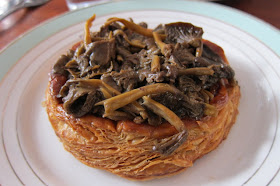 |
Wild Mushroom Tart
at 40 Maltby Street |
The dish pictured above wouldn't be out of place in a top restaurant. However, I ate it in an unpretentious wine bar resounding to the rumbling of trains overhead. Menus are chalked on boards.
Paper napkins come from a dispenser. Perching stools line the bar and bare tables on a painted concrete floor. The railway arch is given character by an original unframed Harry Darby artwork or two.
Hardly star-making surroundings. Just a place where all the attention is on the food and wine - and there just happens to be a Michelin-starred chef in the kitchen.
Chef Steve Williams has a CV which includes The Square, The Ledbury, and The Anchor and Hope and earned his star at The Harwood Arms in 2011, making it the first Michelin starred pub in London. Leaving in 2012 to travel and cook, Williams spent a few months contentedly foraging and cooking at Harry Lester's Auberge du Chassignolle, deep in the Auvergne. Happily for me, he's now back in London cooking at my favourite bar,
40 Maltby Street, making customers very happy.
It's almost 2 years since I first wrote about 40 Maltby Street. Back then it was simply a Friday night dinner venue which served to showcase
Gergovie Wines, albeit with a great chef, Dave Cook, in the small kitchen off the bar. It's grown up a bit since then and, I have to say, has matured nicely. Any place that has managed to attract people at least once a week - I promise you I'm not the only one - for 2 years is certainly deserving of a second review in my book.
 |
| Pollack at 40 Maltby Street |
40 Maltby Street is co-owned by Raef Hodgson and Harry Lester. Back at its birth, a run of trestle tables was set up to accommodate around 40 people. Dishes were served in en famille fashion and were based around, say, a whole lamb or two and whatever else was in season. It was a good formula, albeit one where you had to be open to trying something you might not have been offered before - lamb's pluck is not for everyone!
 |
| Roast Pork at 40 Maltby Street |
Things moved on and now you can eat at 40 Maltby Street Wednesday to Saturday (see below). This has allowed them to have a far broader menu. Dave Cook returned to his native Australia last Summer, making way for Steve Williams. He has gradually changed the menu to his own style and dishes are a broad mix to complement the wines. Working alongside him is Kit Hodgson who specialises in pastry and serves up unmissable pies and puddings.
Apart from being sure the food will be seasonal and impeccably sourced, you can never predict what dishes will be chalked on the blackboard. Possibly a broth; maybe chicken with wild garlic; or lamb with barley and greens; sometimes a Venison or Mock Squab pie or an Onion tart with Lancashire cheese. Often there's a roast and, maybe, a salt-baked fish. There could be Egg mayonnaise, Leek and mussel gratin, Brandade in crispy potato skins, Croquettes, Mushroom tart or Anchovies, kohlrabi and mint. There are always British cheeses, terrines or a plate of charcuterie, and almost always a baked ham on the counter. Last Saturday a simple-looking dish of broccoli, soft-boiled egg and hollandaise sauce with toasted almonds was made outstanding by the use of brown butter and sweet-sour Moscatel vinegar. Pearly flakes of perfectly cooked pollock came with buttery, soft leeks dressed with bacon and chervil, the necessary crunch provided by roast potato.
Seasonal puddings could be Prune and Lemon or, maybe, Damson soufflé, Apple pie fritters, Eve's Pudding, Steamed Treacle sponge with custard, Frangipane tarts, Lemon Posset. I could go on, but I'll spare you the torture. I'm shocked to find I have no recent photos of the puddings. Clearly I just couldn't wait to tuck in. There's usually a number of meat and fish-free dishes. Everything is made in the small open kitchen with skill, passion and generosity.
 |
| Menu at 40 Maltby Street |
If you can resist the food, you can just pop in for a glass of
wine. 40 Maltby Street is one of a small number of bars and restaurants
in London who are introducing a new generation of natural winemakers from
the South-East France/ Northern Italy/Slovenia/Spain wine-growing areas.
Employing ethical methods of growing, some organically or biodynamically,
with little intervention in the development of the wine, produces interesting and surprising results. The yield from these growers is
small, hence the labels on offer at 40 Maltby Street are ever-changing
as they find more good, artisan winemakers. Some can be challenging but I can honestly say there has only been one glass I really didn't enjoy at all. There are always a few bottles open for drinking by the glass and a wider range to enjoy by the bottle. You can also buy to take away. My favourites have to be Tete de Bulle from the Auvergne, anything from Italian winemaker Davide Spillare, a glass of Rosso die Muni from the Veneto and Pacina Rosa from Tuscany. Mark-ups are transparent and remarkably low.
40 Maltby Street draws a diverse crowd from off-duty chefs, through arts and media folk to local residents. Housed in a railway arch beneath the London Bridge to Dover line, it is about a 10-minute walk east of London Bridge Station. It's a wine bar with food so don't expect fancy service, though it is always professional. What you will get is a warm welcome, great wines and food worthy of a Michelin star, all in simple surroundings. It makes me very happy every week.
40 Maltby Street
London SE1 3PA
Open: Wednesday and Thursday 5.30-10pm
Friday 12.30-2pm and 5.30-10pm
Saturday 11am-5pm
(No resercvations)











